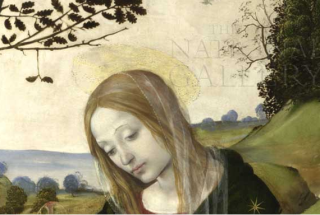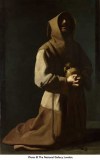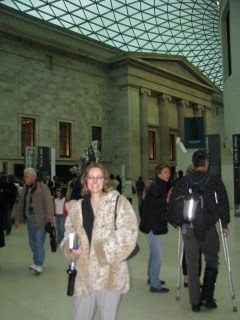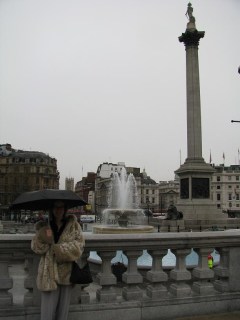We started Friday off in much the same way as we had Thursday – a breakfast at Caffe Nero consisting of pastries and hot chocolate and people watching. We then jumped on the Tube and took it to Trafalgar Square. It was a bit rainy out, but it was light enough that we could see (and take a picture of) the column with Lord Nelson on top. We did not linger in the cool and wet, but proceeded to a side entrance of the National Gallery.
The National Gallery is a free art museum dedicated to paintings. It is quite immense, and we did not see a whole lot of it, even though we were there over two hours. We started off by following the advice of the other man in Mer’s life, Rick Steves. Mer had wisely invested in a copy of Rick Steves’ London before we went, and he gave a layout to see major works in the museum. We saw a few impressive paintings, but wanted to make it back to the entrance in time for a free guided tour.
The tour was given by the quintessential older British tour guide. He had white hair, a blazer and jacket, and a very quirky sense of humor (humour). He was quite good at keeping our attention and at explaining what was going on in the paintings we looked at. He talked about color choices and balance and open and closed figures. He showed us examples of how things changed over time, and showed us how paintings displayed the passage of time in the subject matter. We looked at a total of five paintings in an hour, and it was very good. I am not always a huge fan of paintings (I prefer sculpture in museums), but his talk made the art make much more sense and I quite liked it.

 Of all the art work we saw, I was really taken by two, one of which was Filippino Lippi’s Virgin and Child with Saints Domini and Jerome. Most of the work is very fine, but what captivated me was Mary’s face. It was probably the most human face of any painting of Mary I had ever seen. It was remarkable – as Mer put it, she seems to be a young girl who loves the child she is feeding, and that is the moment the painter caught. The other painting that grabbed my eye was Zurbaran’s St. Francis in Meditation. The paining was very dark, and the use of shadows made the face (what you can see of it) stand out. It really just jumped out
Of all the art work we saw, I was really taken by two, one of which was Filippino Lippi’s Virgin and Child with Saints Domini and Jerome. Most of the work is very fine, but what captivated me was Mary’s face. It was probably the most human face of any painting of Mary I had ever seen. It was remarkable – as Mer put it, she seems to be a young girl who loves the child she is feeding, and that is the moment the painter caught. The other painting that grabbed my eye was Zurbaran’s St. Francis in Meditation. The paining was very dark, and the use of shadows made the face (what you can see of it) stand out. It really just jumped out  at me. What a great painting.
at me. What a great painting.
We left the National Gallery a little after noon, and made our way to the adjacent St.- Martin-in-the-Fields church. This church is famous for helping the poor and for recording great music. We thought it would be a good place to check out for lunch in the now-expected crypt cafe. The cafe was very crowded – we considered ourselves to be lucky to find a table. The food was cafeteria-style, and it was fine, but the more memorable thing to me was eating and chatting in a crypt. The church floor had in-floor tombs, and there were tables set over them. I think I’d be okay with people eating over me after I’m dead, but it struck me certainly as unusual (not a practice I have seen in the States!).
After lunch we took a few minutes to wander around the church. There was a small chapel down one level from the crypt, and as such I was expecting an ancient hole in the wall where you could pray. I was delightfully surprised to find a small and quiet, but very modern and well-lit, chapel capable of holding about 25 people. They served communion there several times a week, and I wish I could have been at a service – I think it would have been very moving.
After the chapel, we popped upstairs to look at the famous church. Again, it surprised me. I had expected another ancient-style cathedral church, but St.-Martin-in-the-Fields is a beautiful, airy, modern church that is tastefully done. Mer and I spent several minutes just sitting in a pew and soaking it all in. Again, I’ll bet a worship service in this church is something to behold.
 We jumped back on the Tube and headed to the British Museum, which is another free museum. This one houses historical artifacts, art, and antiquities that are world famous, including the Rosetta Stone (the first stone that had Egyptian and Greek and Latin on it that allowed scholars to decipher Egyptian hieroglyphs). Once inside the building, you proceed to what is the largest covered public square in England – it is enormous. The famous reading room is in the middle of the court (where Marx wrote), but the famous British Library that used to take up the space of the courtyard was moved out in the nineties, freeing up this extraordinary space.
We jumped back on the Tube and headed to the British Museum, which is another free museum. This one houses historical artifacts, art, and antiquities that are world famous, including the Rosetta Stone (the first stone that had Egyptian and Greek and Latin on it that allowed scholars to decipher Egyptian hieroglyphs). Once inside the building, you proceed to what is the largest covered public square in England – it is enormous. The famous reading room is in the middle of the court (where Marx wrote), but the famous British Library that used to take up the space of the courtyard was moved out in the nineties, freeing up this extraordinary space.
We decided it would be worthwhile to pay for a small-group guided tour, and that was well worth it. Our guide was very knowledgeable and personable. We started out tour by looking at ancient Egyptian sculpture – a head of a statue of a Pharaoh, his arm and hand (oddly), and a touching sculpture of an Egyptian couple holding hands. We then wandered over to look at ancient Assyrian art. We were shown the gate guardians of a major city, which were huge. The guide told us they were discovered by the French, but were too big to move. So, England asked if they could have them, and when told they could, they cut them into quarters and shipped them home. You can see the cuts in the statues if you look for them. The room behind had some impressive bas-reliefs of the Assyrian king on a lion hunt. There were hundreds of figures, and lots of lions everywhere (sadly, in the midst of being killed). Because the king could not be put in too much danger, the lions were wounded before being released from cages, and amazingly that is shown in the mural as well.
We left Assyria and made our way to Greece and the Parthenon. There was a small-scale model of the original temple, and then we were shown the figures that used to adorn the temple near the roof line, all around the structure. Here is an interesting bit of history and politics: in the 1800s a British man went with some artists to sketch the figures, and he saw them being ground up by locals to make concrete. He asked the officials of the Ottoman Empire if he could save the statues, and was given permission to do so. He brought them home, upon which the British officials looked into the matter to see if what he had done was legal. They determined all was well, and the pieces ended up in the British Museum. Now, over 100 years later, the Greek government wants them back. It is such a political issue that the museum guides are not allowed to talk about it, but can only give you a pamphlet explaining both sides.
Anyway, the figures that are in the museum are quite remarkable. They are very accurate, and match in quality what modern sculptors of the human body have managed. And all this was done 2500 years ago. Not too bad for lacking power tools!
After Greece, we made a detour back to Egypt to look at mummies. Our guide went over the history of mummification and some of the process behind it. We looked at the shrouds and outer sarcophagi of several burial sites. Most were very well preserved. Oh – and the museum has never unwrapped a mummy, but it does do CAT scans on them from time to time to get an idea of what the person may have looked like.
Our guide then pointed us toward Roman Britain, but had to leave us at that point. We wandered through that section, and made our way to the Anglo-Saxons so that Meredith could see some of the artwork that is in her textbook accompanying the epic poem Beowulf. Having found her helmet and shield, we made our way out through a display on clocks and time pieces, and made our way back out into the evening air.
We continued out multicultural dining experience by eating at a Thai restaurant near the museum. It again was quite good and hearty, but the desserts were merely okay.
We Tubed it over toward our next destination, which after a healthy walk turned out to be the Tate Modern Art Museum. Mer was a trooper, I have to say. My back had gotten messed up on the plane, and I was in a lot of pain going in to our third museum of the day. I was having a hard time walking, so I was not in a great mood. Add to that the fact that I strongly dislike modern art that fails the “Matt Test,” and you do not have a recipe for a good time. To my credit, I tried to behave, and Mer put up with my sudden air of indignation.
If you are wondering, the “Matt Test” for art is simply the answer to “Could I have done that?” If the answer is yes, 95% of the time I will not consider it art. If the answer is no, I give it a chance. I do like some modern art – I usually like modern religious art (no, not Thomas Kinkade!), and I like modern sculpture and some painting. I also have no patience for art that is clearly just being “artsy” – the art films (ALWAYS shot in black and white with random soundtracks) usually fall into this category. My least favorite works in the museum were (I’m not joking) a two-deep pile of bricks, which were next to another “work” of three framed but blank canvasses. No offense to the artists, but come on. Way to fail the Matt Test with flying colors. I also don’t buy the “But they had to think of it” argument that is sometimes bandied about. At any given moment, I can describe to you an original art piece that I can make symbolize something grand sounding, and I have no training. Test me on this sometime – it’s fun!
I did like a sculpture by Picasso that was a study for one of his paintings. I liked quite a few of the paintings from the 20s and 30s. I liked a piece called “30 pieces of silver” where squashed silver was hung from the ceiling to within six inches of the floor.
I finally had to give up and rest my back and my indignation, but Meredith went on. Apparently I missed the modern art sex room and and modern art violence room. Somehow, I do not feel I missed much.
We took the Tube back home to the Docklands. A burger joint was still open (it was 10ish), and so I got what turned out to be really good fries (chips) and a very bland shake. I ate these back in the room while listening to the iPod playing Christmas music through the hotel alarm clock (which had an auxiliary-in port). And so we closed out day 3 of our English holiday.

Ahah… the Tate Modern. We briefly studied it in my museology class, and I have to say…we were never a fan of how egotistical the place is.
Hmm…I’ll have to take you up on this art challenge. I have my own opinions on what classifies art as art, and it’d be interesting to have a dialogue!
One of my favorite experiences in England was visiting Coventry Cathedral. The cathedral is modern for the reason that the old cathedral was burned to a husk in WWII. The husk was left right outside the new cathedral to serve as a monument to the destruction caused by war. Every day at noon they hold a service to pray for peace and forgiveness. I’m not the world’s most emotional guy, but sitting inside a beautiful modern cathedral with a stark and strong reminder of the price of war left just outside the door…it really choked me up.
The cathedral also has beautiful etched glass for the entrance depicting an angel (a specific one I’m now blanking on). Very nice.
I actually asked Shannon to bring home the Zurbaran’s Christ on the Cross from work for me as it’s my favorite painting in the AI. He did get me a lovely print, which you can see alongside him in his Halloween costume!
I echo Shannon in urging you to visit Coventry Cathedral one day. The new church extends over the bombed out cathedral in a protective manner. I’ll have to pull up my pics. It’s the most moving church I’ve ever seen – more of an experience, really, than just a building. The priest offers prayers for peace and forgiveness several times a day and invites whoever is visiting to pray as well. Apparently, it has a sister cathedral in Berlin which the Allies had bombed out. Like Coventry, the husk is there with the new church alongside.
IIRC the National Gallery is near the Theatre District. The Dervish & I went in on the spur of the moment around 7pm or, I think. Pretty cool. I got to see a portrait of the king I’m named after.
The Tate Modern is a remarkable building. I may have to adopt the “Matt test” myself. I’ll ask myself, when staring at contemporary art, could Matt have done this?
Which no most things is “no!”.